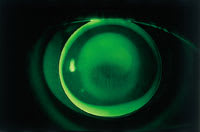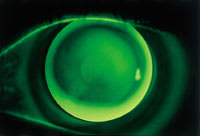contact lens case reports
NSAIDs in RGP Adaptation
BY PATRICK J. CAROLINE, FAAO, FCLSA, & MARK P. ANDRÉ,
FAAO, FCLSA
May 2001
Patient D.W. is a 25-year-old dental student with a four-year history of keratoconus. He had been successfully wearing spectacles until recently when he reported a decrease in distance and near vision secondary to progression of his condition. Subsequently he reported difficulties performing his professional duties which prompted him to pursue RGP lenses.
|
|
|
| Figure 1. Fluorescein pattern of the right eye | Figure 2. Fluorescein pattern of the left eye |
The RGP fitting was unremarkable (Figures 1 and 2); however, the patient complained of excessive lens awareness OU and an inability to maintain a consistent wearing schedule. In an attempt to enhance RGP adaptation, the patient was placed on a five-day course of Voltaren (diclofenac, Novartis).
Topical non-steroidal anti-inflammatory drugs (NSAIDs) are a class of drugs commonly used to reduce or inhibit: intraoperative miosis, postoperative inflammation, post surgical or post trauma corneal pain and photophobia and ocular itching caused by seasonal allergies.
Four topical ocular NSAIDs are available: Acular, (ketorolac, Allergan), Profenal, (suprofen, Alcon), Ocufen (flurbiprofen, Allergan) and Voltaren.
|
TABLE 1:Suggested NSAID Dosage for RGP Adaptation |
|
The regimen can be maintained for 3 to 5 days or until adaptation is completed. |
|
Mechanisms Of Action
The mechanism of action of all NSAIDs is to reduce prosta-glandin production through inhibition of the prostaglandin synthetic enzyme, cyclo-oxygenase. Since prostaglandins are mediators of pain, reducing their production reduces pain. Of the NSAIDs currently on the market, Acular and Voltaren have been shown to pos-ses significant analgesic effects at the ocular surface. Voltaren appears to be the most effective drug within the class at inhibiting prostaglandin synthesis.
Clinical studies at the Doheny Eye Institute in Los Angeles and at the Gimbel Eye Center in Calgary, have clearly shown that the analgesic effects of Voltaren significantly increased only after multiple repeated dosage (three or more drops).
To enhance RGP adaptation, we have found the dosage in Table 1 to be the most effective. In our case, the patient reported a significant improvement in his ability to adapt to RGP lenses and now enjoys the benefits of all day lens wear.
NSAIDs have the ability to control pain over a wide range of ocular surface conditions. In healthy eyes, Voltaren possesses few potential risks and therefore in selected cases, it may prove to be successful in enhancing lens adaptation.
Patrick Caroline is an associate professor of optometry at Pacific University and an assistant professor of ophthalmology at the Oregon Health Sciences University.
Mark André is director of contact lens services at the Oregon Health Sciences University.





